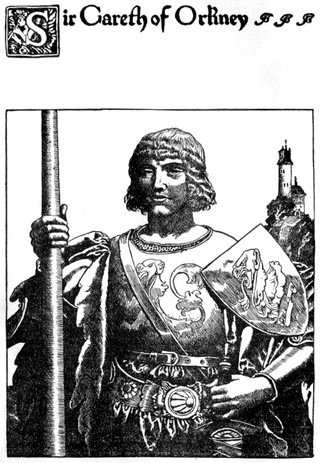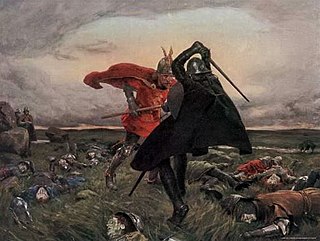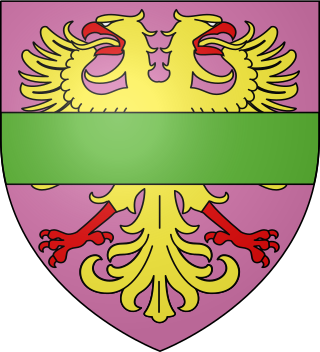Related Research Articles

Excalibur is the mythical sword of King Arthur that may possess magical powers or be associated with the rightful sovereignty of Britain. Traditionally, the sword in the stone that is the proof of Arthur's lineage and the sword given to him by a Lady of the Lake are not the same weapon, even as in some versions of the legend both of them share the name of Excalibur. Several similar swords and other weapons also appear within Arthurian texts, as well as in other legends.

Guinevere, also often written in Modern English as Guenevere or Guenever, was, according to Arthurian legend, an early-medieval queen of Great Britain and the wife of King Arthur. First mentioned in popular literature in the early 12th century, nearly 700 years after the purported times of Arthur, Guinevere has since been portrayed as everything from a fatally flawed, villainous and opportunistic traitor to a noble and virtuous lady. Many records of the legend also feature the variably recounted story of her abduction and rescue as a major part of the tale.

Gawain, also known in many other forms and spellings, is a character in Arthurian legend, in which he is King Arthur's nephew and one of the premier Knights of the Round Table. The prototype of Gawain is mentioned under the name Gwalchmei in the earliest Welsh sources. He has subsequently appeared in many Arthurian tales in Welsh, Latin, French, English, Scottish, Dutch, German, Spanish, and Italian, notably as the protagonist of the Middle English poem Sir Gawain and the Green Knight. Other works featuring Gawain as their central character include De Ortu Waluuanii, Diu Crône, Ywain and Gawain, Golagros and Gawane, Sir Gawain and the Carle of Carlisle, L'âtre périlleux, La Mule sans frein, La Vengeance Raguidel, Le Chevalier à l'épée, Le Livre d'Artus, The Awntyrs off Arthure, The Greene Knight, and The Weddynge of Syr Gawen and Dame Ragnell.

Lancelot du Lac, also written as Launcelot and other variants, is a character in some versions of Arthurian legend where he is typically depicted as King Arthur's close companion and one of the greatest Knights of the Round Table. In the French-inspired Arthurian chivalric romance tradition, Lancelot is an orphaned son of King Ban of the lost kingdom of Benoic, raised in a fairy realm by the Lady of the Lake. A hero of many battles, quests and tournaments, and famed as a nearly unrivalled swordsman and jouster, Lancelot becomes the lord of the castle Joyous Gard and personal champion of Arthur's wife, Queen Guinevere, despite suffering from frequent and sometimes prolonged fits of madness. But when his adulterous affair with Guinevere is discovered, it causes a civil war that, once exploited by Mordred, brings an end to Arthur's kingdom.

Mordred or Modred is a figure in the legend of King Arthur. The earliest known mention of a possibly historical Medraut is in the Welsh chronicle Annales Cambriae, wherein he and Arthur are ambiguously associated with the Battle of Camlann in a brief entry for the year 537. Medraut's figure seemed to have been regarded positively in the early Welsh tradition and may have been related to that of Arthur's son.

The Knights of the Round Table are the legendary knights of the fellowship of King Arthur that first appeared in the Matter of Britain literature in the mid-12th century. The Knights are an order dedicated to ensuring the peace of Arthur's kingdom following an early warring period, entrusted in later years to undergo a mystical quest for the Holy Grail. The Round Table at which they meet is a symbol of the equality of its members, who range from sovereign royals to minor nobles.

Bedivere is one of the earliest characters to be featured in the legend of King Arthur, originally described in several Welsh texts as the one-handed great warrior named Bedwyr Bedrydant. Arthurian chivalric romances, inspired by his portrayal in the chronicle Historia Regum Britanniae, portray Bedivere as a Knight of the Round Table of King Arthur who serves as Arthur's marshal and is frequently associated with his brother Lucan and his cousin Griflet as well as with Kay. In the English versions, Bedivere notably assumes Griflet's hitherto traditional role from French romances as the one who eventually returns Excalibur to the Lady of the Lake after Arthur's last battle.

Le Morte d'Arthur is a 15th-century Middle English prose reworking by Sir Thomas Malory of tales about the legendary King Arthur, Guinevere, Lancelot, Merlin and the Knights of the Round Table, along with their respective folklore. In order to tell a "complete" story of Arthur from his conception to his death, Malory compiled, rearranged, interpreted and modified material from various French and English sources. Today, this is one of the best-known works of Arthurian literature. Many authors since the 19th-century revival of the legend have used Malory as their principal source.
Morgause is a popular variant of the figure of the Queen of Orkney, an Arthurian legend character also known by various other names and appearing in different forms of her archetype. She is notably the mother of Gawain and often also of Mordred, both key players in the story of her brother King Arthur and his downfall. Her other children may include Agravain, Gareth and Gaheris.

Gareth is a Knight of the Round Table in Arthurian legend. He is the youngest son of King Lot and Queen Morgause, King Arthur's half-sister, thus making him Arthur's nephew, as well as brother to Gawain, Agravain and Gaheris, and either a brother or half-brother of Mordred. Gareth is particularly notable in Le Morte d'Arthur, where one of its eight books is named after and largely dedicated to him, and in which he is also known by his nickname Beaumains.

The Battle of Camlann is the legendary final battle of King Arthur, in which Arthur either died or was fatally wounded while fighting either alongside or against Mordred, who also perished. The original legend of Camlann, inspired by a purportedly historical event said to have taken place in the early 6th-century Britain, is only vaguely described in several medieval Welsh texts dating from around the 10th century. The battle's much more detailed depictions have emerged since the 12th century, generally based on that of a catastrophic conflict described in the pseudo-chronicle Historia Regum Britanniae. The further greatly embellished variants originate from the later French chivalric romance tradition, in which it became known as the Battle of Salisbury, and include the 15th-century telling in Le Morte d'Arthur that remains popular today.
Constantine was a 6th-century king of Dumnonia in sub-Roman Britain, who was remembered in later British tradition as a legendary King of Britain. The only contemporary information about him comes from Gildas, who castigated him for various sins, including the murder of two "royal youths" inside a church. The historical Constantine is also known from the genealogies of the Dumnonian kings, and possibly inspired the tradition of Saint Constantine, a king-turned-monk venerated in Southwest Britain and elsewhere.

Gaheris is a Knight of the Round Table in the chivalric romance tradition of Arthurian legend. A nephew of King Arthur, Gaheris is the third son of Arthur's sister or half-sister Morgause and her husband Lot, King of Orkney and Lothian. He is the younger brother of Gawain and Agravain, the older brother of Gareth, and half-brother of Mordred. His figure may have been originally derived from that of a brother of Gawain in the early Welsh tradition, and then later split into a separate character of another brother, today best known as Gareth. German poetry also described him as Gawain's cousin instead of brother.

Agravain is a Knight of the Round Table in Arthurian legend, whose first known appearance is in the works of Chrétien de Troyes. He is the second eldest son of King Lot of Orkney with one of King Arthur's sisters known as Anna or Morgause, thus nephew of King Arthur, and brother to Sir Gawain, Gaheris, and Gareth, as well as half-brother to Mordred. Agravain secretly makes attempts on the life of his hated brother Gaheris starting in the Vulgate Cycle, participates in the slayings of Lamorak and Palamedes in the Post-Vulgate Cycle, and murders Dinadan in the Prose Tristan. In the French prose cycle tradition included in Thomas Malory's Le Morte d'Arthur, together with Mordred, he then plays a leading role by exposing his aunt Guinevere's affair with Lancelot, which leads to his death at Lancelot's hand.
Lucius Tiberius is a Western Roman procurator or emperor from Arthurian legend in which he is killed in a war against King Arthur. First appearing in Geoffrey of Monmouth's pseudo-historical work Historia Regum Britanniae, Lucius also features in later, particularly English literature such as the Alliterative Morte Arthure and Thomas Malory's Le Morte d'Arthur. The motif of a Roman Emperor defeated by Arthur is found in the Old French literature as well, notably in the Vulgate Cycle.

Lamorak is a Knight of the Round Table in Arthurian legend. Introduced in the Prose Tristan, Lamorak reappears in later works including the Post-Vulgate Cycle and Thomas Malory's compilation Le Morte d'Arthur. Malory refers to him as Arthur's third best knight, only inferior to Lancelot and Tristan, and the Prose Tristan names his as one of the top five, but Lamorak was not exceptionally popular in the romance tradition, confined to the cyclical material and subordinate to more prominent characters.
The Alliterative Morte Arthure is a 4346-line Middle English alliterative poem, retelling the latter part of the legend of King Arthur. Dating from about 1400, it is preserved in a single copy in the 15th-century Lincoln Thornton Manuscript, now in Lincoln Cathedral Library.
The Awntyrs off Arthure at the Terne Wathelyne is an Arthurian romance of 702 lines written in Middle English alliterative verse. Despite its title, it centres on the deeds of Sir Gawain. The poem, thought to have been composed in Cumberland in the late 14th or early 15th century, survives in four different manuscripts from widely separated areas of England.
Bagdemagus, also known as Bademagu, Bademagus, Bademaguz, Bagdemagu, Bagomedés, Baldemagu, Baldemagus, Bandemagu, Bandemagus, Bangdemagew, Baudemagu, Baudemagus, and other variants, is a character in the Arthurian legend, usually depicted as king of the land of Gorre and a Knight of the Round Table. He originally figures in literature the father of the knight Maleagant, who abducts King Arthur's wife Queen Guinevere in several versions of a popular episode. Bagdemagus first appears in French sources, but the character may have developed out of the earlier Welsh traditions of Guinevere's abduction, an evolution suggested by the distinctively otherworldly portrayal of his realm. He is portrayed as a kinsman and ally of Arthur and a wise and virtuous king, despite the actions of his son. In later versions, his connection to Maleagant disappears altogether.
The Death of Arthur may refer to:
References
- ↑ Hemingway, Samuel Burdett, ed. (1912). Le Morte Arthur: A Middle English Metrical Romance. Houghton, Mifflin. p. iii.
- ↑ Ackerman pp. 489–90
- ↑ Weinberg p. 111
- ↑ Stone p. 169
- 1 2 Weinberg p. 100
- ↑ Benson and Foster p. 4
- ↑ Kahn, Sharon (1986). The Stanzaic Morte: A Verse Translation of Le Morte Arthur . Lanham, MD: University Press of America. p. vi. ISBN 0819154261.
- ↑ Benson and Foster pp. 4–5
- ↑ Ackerman p. 490
- ↑ Bruce p. vii
- ↑ Johnston p. 19
- ↑ Bruce pp. vii–viii
- 1 2 Bruce p. viii
- ↑ Johnston p. 113
- ↑ Warton, Thomas (1774–81). The History of English Poetry: From the Close of the Eleventh to the Commencement of the Eighteenth Century. Vol. 2. London: J. Dodsley. pp. 206–207.
- ↑ Ritson, Joseph (1782). Observations on the Three First Volumes of The History of English Poetry. London: J. Stockdale. p. 10.
- ↑ Johnston pp. 171–2
- ↑ Ellis, George (1811) [1805]. Specimens of Early English Metrical Romances, Chiefly Written During the Early Part of the Fourteenth Century. Vol. 1. London: Longman, Hurst, Rees, Orme and Brown. p. 324.
- ↑ Bruce p. ix
- ↑ Benson and Foster pp. 3–4
- 1 2 Goodman p. 41
- ↑ Stone pp. 7, 11
- ↑ Mehl, Dieter (1968). The Middle English Romances of the Thirteenth and Fourteenth Centuries. London: Routledge & Kegan Paul. pp. 186, 193.
- ↑ Woolf, Rosemary (1970). "Later Poetry: The Popular Tradition". In Bolton, W. F. (ed.). The Middle Ages. History of Literature in the English Language. London: Sphere. p. 277. ISBN 0214650804.
- ↑ Paton, Lucy Allen, ed. (1914). Morte Arthur: Two Early English Romances. Everyman's Library. London: Dent. pp. xv–xvi.
- ↑ Ackerman p. 489
- ↑ Kane, George (1970) [1951]. Middle English Literature: A Critical Study of the Romances, the Religious Lyrics, Piers Plowman. New York: Barnes & Noble. pp. 65–66. ISBN 9780416077001 . Retrieved 8 March 2013.
- ↑ "Lordings that are lief and dear". Index of Middle English Verse. Centre for Digital Discourse and Culture, Virginia Tech. Retrieved 6 April 2012.
- ↑ Benson and Foster p. 9
- ↑ "COPAC catalogue entry". Copac National, Academic, and Specialist Library Catalogue. Retrieved 6 April 2012.